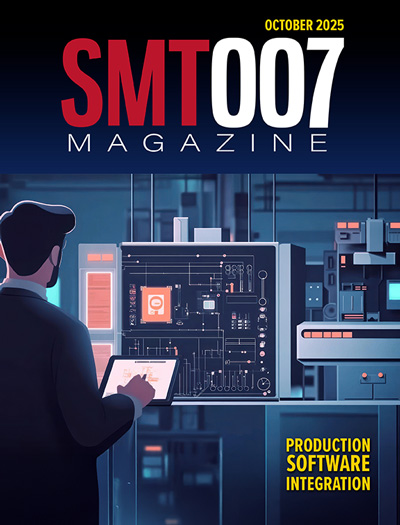-

- News
- Books
Featured Books
- smt007 Magazine
Latest Issues
Current Issue
Production Software Integration
EMS companies need advanced software systems to thrive and compete. But these systems require significant effort to integrate and deploy. What is the reality, and how can we make it easier for everyone?

Spotlight on India
We invite you on a virtual tour of India’s thriving ecosystem, guided by the Global Electronics Association’s India office staff, who share their insights into the region’s growth and opportunities.

Supply Chain Strategies
A successful brand is built on strong customer relationships—anchored by a well-orchestrated supply chain at its core. This month, we look at how managing your supply chain directly influences customer perception.
- Articles
- Columns
- Links
- Media kit
||| MENU - smt007 Magazine
Estimated reading time: 4 minutes
How Much is Too Much?
One of the typical questions process engineers pose regarding the PCB rework process is, "How many heat cycles are too much?” Asked in another way, the question is, “How would one define a limit on the number of times a PCB can be reworked while still being reasonably assured that the reliability has not been impacted based on its operational environment?"
The answer will depend on a multitude of factors, but it is largely influenced by the board’s function in the end-use operating environment. For example, an airplane control module that is protecting passengers while in flight (Class 3) has a different set of maximum conditions compared to a giveaway toy that came from the local fast food eatery (Class 1). In reviewing this topic, consider that rework cycles consume part of the useful thermomechanical life of the PCB.
There are several factors to consider when calculating the maximum number of allowable rework cycles. Some of the most relevant factors include PCB design, materials (including the components involved in the design of the PCB), and the number of heat cycles or heating and cooling cycles the board has experienced. The multitude of factors and there being no one number is also supported in the rework and repair guidelines document, IPC-7711/21, which states as follows, "This document does not limit the maximum number of rework, modification, or repair actions to a printed circuit assembly."
Figure 1: How many times should I attempt to rework a PCB?
PCB design has an impact on how the many cycles should be allowed for rework. There are hearty laminates that can take multiple heat cycles. Higher layer count PCBs with high aspect ratios through vias are more prone to failure after only a few soldering cycles if the materials of construction are not robust. In general, larger pads hold up under more heat cycles; however, with smaller pads, there is a greater chance of board delamination after only a few cycles. Testing and experimentation via life cycle testing will show what is right for your specific application and end-use operating environment. A well-chosen material set will, in most cases, withstand up to six heat cycles (three rework cycles) for the majority of Class-2 or Class-3 designs.
The materials included in the design of the PCB (including the components and boards) have an impact on the maximum number of rework or heat cycles that an electronics assembly can withstand. As a reminder, an entire assembly can be compromised if only a single component is damaged. Make sure to look up the specifications for all of the components to investigate the temperature limit specified by the component manufacturer. It’s important to note here that passive components may have a lower time-over-temperature exposure limit than larger active components. This is known in the component specification world as the process sensitivity level (PSL). Furthermore, check what these values mean for other elements on a PCB, which are further defined in the IPC J-STD-075: Classification of Non-IC Electronic Components for Assembly Processes. During a reflow process, the board is stressed as well as the solder joints and all of the components.
The total number of heat and cooling cycles should be part of the decision to limit the number of rework cycles. In general, the typical number of rework attempts (multiply by two to get to the number of heat cycles) for Class-2 and Class-3 PCBs is three. Make sure to enumerate all of the heat cycles the board has already gone through. For a typical double-sided PCB, this could include both the primary side component placement and reflow as well as the secondary side placement and reflow.
Develop a profile for each of the processes using a thermal profiler to prove that you have not exceeded any of the component temperature/time limits. If we simply remove and replace one of the devices, then the count of reflow cycles already numbers four. For BGAs and other active devices, the usual number of heat excursions is equal to the number of times the die is exposed to the liquidus temperature of the soldering alloy used. However, wave soldering, baking, and conformal coating curing processes may heat and relax the PCB. If reballing of the device is required, then another two heat cycles—one for the removal of the BGA balls and the other for the re-attachment reflow—must be added to the total. There are some ball removal processes that do not raise the die temperature above liquidus.
In addition to the technical limitations placed on the maximum number of rework cycles, there are also economic decisions that may drive the cost versus benefit of a rework process. Many times, the alternatives evaluated include the removal and replacement of the device or scrapping the board and replacing with a new assembly. At times, the cost and availability of these options push the decision in a certain direction. PCB rework yields, overhead costs, and opportunity costs in using labor (which could be producing higher margin PCBs) enter the decision-making process. Thus, the question that needs to be answered is, "When is too much too much?"
Further Reading
1. IPC—Association Connecting Electronics Industries. “IPC-7711/21: Rework, Modification, and Repair of Electronic Assemblies.” November 1, 2011.
2. Coyle, R., Meilunas, M., Popowich, R., Anselm, M., Read, P., Oswald, M., & Fleming, D. “Interconnection Reliability of Interposer and Reballing Options for BGA Backward Compatibility.” SMTA International proceedings, October 14, 2012.
3. Ma, H., Xie, W., Subbarayan, G., & Lieu, K.C. “Effects of Multiple Rework on the Reliability of Lead-free Ball Grid Array Assemblies.” IEEE 61st Electronic Components and Technology Conference, 2011.
More Columns from Knocking Down the Bone Pile
Knocking Down the Bone Pile: Revamp Your Components with BGA ReballingKnocking Down the Bone Pile: Best Practices for Electronic Component Salvaging
Knocking Down the Bone Pile: Addressing End-of-life Component Solderability Issues, Part 4
Knocking Down the Bone Pile: Tin Whisker Mitigation in Aerospace Applications, Part 3
Knocking Down the Bone Pile: Gold Mitigation for Class 2 Electronics
Knocking Down the Bone Pile: Basics of Component Lead Tinning
Knocking Down the Bone Pile: Package on Package Rework—Skill Required
Knocking Down the Bone Pile: 2023’s Top Challenges in BGA Rework


